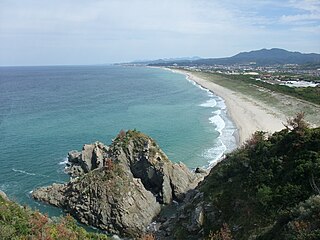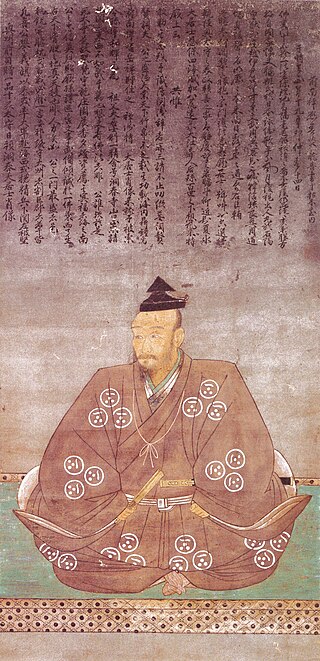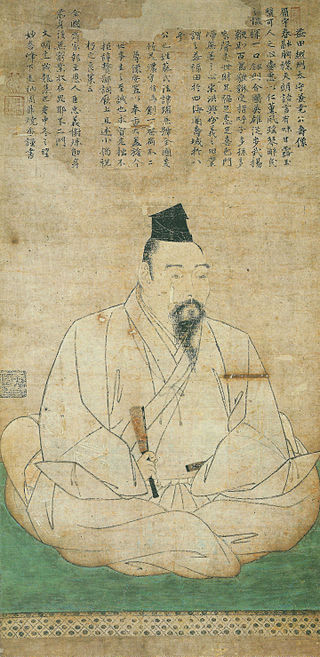This article may be confusing or unclear to readers.(July 2009) |
The Masudaclan was a Japanese clan in the Iwami Province (present-day Shimane Prefecture), Japan, from the 13th century until 1600. [1]
This article may be confusing or unclear to readers.(July 2009) |
The Masudaclan was a Japanese clan in the Iwami Province (present-day Shimane Prefecture), Japan, from the 13th century until 1600. [1]

Fujiwara Kunikane started his new post as Iwami provincial governor in the 11th century, the end of the Heian period. At that time, the Lwami government was in the city of Hamada.
However, the fourth Lord Masuda, Kanetaka (兼高) moved their base to the Masuda, a strategic point for the traffic and a suitable place for a port. He also changed his family name from Fujiwara to Masuda, the name of this area. Kanetaka Masuda decided to belong to the new power Genji. He became a commander of the Genji military and fought against the Heike.
His army belonged to Minamoto no Yoshitsune and served in the Battle of Ichi-no-Tani (1184) and the Battle of Dan-no-ura (1185), in which Heike was annihilated. Meanwhile, Kanetaka Masuda saved power steadily and ruled about a one-third of Iwami in the early days of the Kamakura period.
The 11th Lord Masuda, Kaneharu (兼晴), was allied with the powerful Ōuchi clan in Yamaguchi. The 15th Lord Masuda, Kanetsu (兼堯), was involved in many battles, including the Ōnin War (1467). However, he was also involved with culture. He invited the artist Sesshū Tōyō to Masuda, and it is said that Sesshū drew his "Portrait of Kanetsu (益田兼堯像)" out of gratitude for Kanetsu's hospitality.
In those days, there were many small battles between clans, and warriors were not separated. Everybody was armored and protected their land. Masuda was opposed to neighboring powers, such as the Mori clan, the Yoshimi clan, and the Amago clan. Meanwhile, the Mori family was becoming more powerful and the Ouchi clan less so. The Masuda clan allied itself with the Mori clan.
The 19th lord of Masuda, Fujikane (藤兼), made peace with the Mori clan. It is left in the Masuda’s document that he gave various kinds of gift to the Mori clan. It was written in the Korean book that Masuda had trade with other countries.
The Masuda clan got an important post from Mōri Motonari, and the 20th lord of Masuda, Motoyoshi (元祥), was given a character "Moto" (元), from Motonari (元就), to his name.
Motoyoshi widened his territory from Nagato Province in present-day Yamaguchi Prefecture to Izumo Province in present-day Shimane Prefecture, and a part of Kyūshū.
At the Battle of Sekigahara (1600), the Mori and Masuda clans belonged to the Toyotomi group, but he did not send his army to the battle.
Although he was allowed to keep his territory by Tokugawa Ieyasu, the Shogun of Edo period, he chose to follow the Mori clan and left Masuda, as the Mori clan was bottled up into a small area, Susa in Nagato.
Masuda city had been a Nanao castle town for 400 years under Masuda administration.

Yamaguchi Prefecture is a prefecture of Japan located in the Chūgoku region of Honshu. Yamaguchi Prefecture has a population of 1,377,631 and has a geographic area of 6,112 km2. Yamaguchi Prefecture borders Shimane Prefecture to the north and Hiroshima Prefecture to the northeast.

Shimane Prefecture is a prefecture of Japan located in the Chūgoku region of Honshu. Shimane Prefecture is the second-least populous prefecture of Japan at 665,205 and has a geographic area of 6,708.26 km2. Shimane Prefecture borders Yamaguchi Prefecture to the southwest, Hiroshima Prefecture to the south, and Tottori Prefecture to the east.

Mōri Motonari was a prominent daimyō in the western Chūgoku region of Japan during the Sengoku period of the 16th century. The Mōri clan claimed descent from Ōe no Hiromoto (大江広元), an adviser to Minamoto no Yoritomo. Motonari was called the "Beggar Prince". He was known as a great strategist who began as a small local warlord (jizamurai) of Aki Province and extended his clan's power to nearly all of the Chūgoku region through war, marriage, adoption and assassination.

Amago Tsunehisa was a powerful warlord who gained the hegemony in Chūgoku region, Japan starting as a vassal of the Rokkaku clan. He ruled the domains of Inaba, Hōki, Izumo, Iwami, Oki, Harima, Mimasaka, Bizen, Bitchū, Bingo, and Aki.

The Mōri clan was a Japanese samurai clan descended from Ōe no Hiromoto. Ōe no Hiromoto was descended from the Fujiwara clan. The family's most illustrious member, Mōri Motonari, greatly expanded the clan's power in Aki Province. During the Edo period his descendants became daimyō of the Chōshū Domain under the Tokugawa shogunate. After the Meiji Restoration with the abolition of the han system and daimyō, the Mōri clan became part of the new nobility.

Suō Province was a province of Japan in the area that is today the eastern part of Yamaguchi Prefecture. Suō bordered on Aki, Iwami, and Nagato Provinces.

Iwami Province was an old province of Japan in the area that is today the western part of Shimane Prefecture. It was sometimes called Sekishū (石州). Iwami bordered Aki, Bingo, Izumo, Nagato, and Suō provinces.
Sue Harukata was a samurai who served as a senior retainer of the Ōuchi clan in the Sengoku period in Japan. He was the second son of Sue Okifusa, a senior retainer of the Ōuchi clan. His childhood name was Goro, and he previously had the name Takafusa.

Ōuchi clan was one of the most powerful and important families in Western Japan during the reign of the Ashikaga shogunate in the 12th to 14th centuries. Their domains, ruled from the castle town of Yamaguchi, comprised six provinces at their height, and the Ōuchi played a major role in supporting the Ashikaga in the Nanboku-cho Wars against the Imperial Court. The Ōuchi remained powerful up until the 1560s, when they were eclipsed by their vassals, the Mōri clan.

Ōuchi Yoshioki became a sengoku daimyō of Suō Province and served as the 15th head of the Ōuchi clan. Yoshioki was born early in the Sengoku period, the son of Ōuchi Masahiro, shugo of Suō Province and the 14th head of the Ōuchi clan. The first character in Yoshioki's name originated from Ashikaga Yoshihisa, the ninth shōgun in the Muromachi bakufu. In 1492, Masahiro ordered Yoshioki to join the battle against Rokkaku Takayori, a sengoku daimyō from southern Ōmi Province. In the midst of this engagement in 1493, an incident known as the Meiō no seihen occurred, by which Hosokawa Masamoto, a kanrei, or deputy, held the shōgun, Ashikaga Yoshiki, in confinement. Yoshioki withdrew his men from the battle to Hyōgo in Settsu Province to wait for the outcome of the event, which resulted in Yoshiki being deposed and replaced by Ashikaga Yoshizumi. Yoshioki's younger sister was abducted while staying in Kyōto in an area under the control of Takeda Motonobu, an ally of Hosokawa Masamoto. Masamoto took her hostage as leverage against Masahiro in his support for Yoshiki. Masahiro then ordered close associates of Yoshioki to commit seppuku. This may have been as retribution for what he viewed as Yoshioki's tepid response to the pressure exerted upon him by Masamoto and his retainers. Nevertheless, Yoshioki's decision to withdraw his forces was well-received by the hikan, or administrators, in his birthplace of Kyōto, building relationships that benefit him later at the time of his succession to Masahiro.

Kobayakawa Takakage was a samurai and daimyō during the Sengoku period and Azuchi–Momoyama period. He was the third son of Mōri Motonari who was adopted by the Kobayakawa clan and became its 14th clan head. He merged the two branches of the Kobayakawa, the Takehara-Kobayakawa clan (竹原小早川氏) and Numata-Kobayakawa clan (沼田小早川氏). He became an active commander of the Mōri army and he with his brother Kikkawa Motoharu became known as the “Mōri Ryōsen", or “Mōri's Two Rivers" (毛利両川). As head of the Kobayakawa clan, he expanded the clan's territory in the Chūgoku region, and fought for the Mōri clan in all their campaigns

Hagi Castle was a Japanese castle located in the city of Hagi, Yamaguchi Prefecture, in the San'yō region of Japan. Built in 1604 at the beginning of the Edo period as the main castle of the Mōri clan, it served as the seat of the Chōshū Domain for over 250 years until 1863. It was demolished in 1874 shortly after the Meiji Restoration. Its ruins were designated a National Historic Site in 1924. Hagi Castle has been designed as a component of the Sites of Japan's Meiji Industrial Revolution: Iron and Steel, Shipbuilding and Coal Mining, which received UNESCO World Heritage Site status in 2015.
Hayashi Narinaga was a samurai during the Sengoku period, retainer of the Mōri clan and was a ji-samurai (koku-jin-ryōshū) of southern Bingo Province. He held many positions including karō serving Mōri Motonari and his father Mōri Hiromoto in diplomatic missions with Toyotomi Hideyoshi. Narinaga was a bugyō under Mōri Terumoto. From Hideyoshi he received the rank of Hizen-no-kami (肥前守). He served as diplomat between the Mōri and Hideyoshi. Later he was bestowed the 5th court rank, junior grade Ju go-i-no-ge (従五位). The character "nari, 就" came from his lord Mōri Motonari and "naga, 長" from his father Kikuchi Takenaga. Narinaga was one of the few to live through all the Sengoku period.

Sesshū Memorial Museum opened in Masuda, Shimane Prefecture, Japan, in 1990. Located next to the site of the Daiki-an (大喜庵), said to have been the site of Sesshū's death and burial, the museum stages exhibitions relating to the artist and to the history of Masuda. The collection includes one Important Cultural Property, Sesshū's 1479 portrait of Masuda Kanetaka; two Prefectural Cultural Properties, Yasutomi Family Documents (安富家文書) and Sufu Family Documents (周布家文書); and seven Municipal Cultural Properties, three scrolls with flowers and birds attributed to Sesshū, a pair of landscape byōbu by Unkoku Tōeki, Daruma, Ikuzanshu, and Seiōgyū by the same painter, sailing boats in an autumn bay and travel through snow-covered mountains by the same artist, lotus and heron by Saitō Tōshitsu (斎藤等室筆), Daruma by Unkoku Tōoku (雲谷等屋), and Yoshida Family Documents (吉田家文書).

Tsuwano Castle was a Japanese castle located in what is now the city of Tsuwano, Shimane Prefecture, in the San'in region of far western Japan. Its ruins have been protected by the central government as a National Historic Site since 1942. In its early history, it was called Sanbonmatsu Castle or Ipponmatsu Castle. During the Edo Period, it was the center of Tsuwano Domain ruled by the Kamei clan; however, the administrative offices and daimyō residence were located at the base of the mountain to avoid the steep mountain paths.

Yoshida-Kōriyama Castle was a Japanese castle located in Akitakata, Hiroshima Prefecture. It was also called Aki-Kōriyama Castle from its location in former Aki Province. Its ruins have been protected by the central government as a National Historic Site since 1940.
Mōri Hiromoto was a local warlord (jizamurai) of Aki Province in the west Chūgoku region of Japan during the Muromachi period and Sengoku period of the 16th century. The Mōri clan claimed descent from Ōe no Hiromoto, an adviser to Minamoto no Yoritomo. He is most known as the father of the famous Mōri Motonari.

Ikō-ji (医光寺) is a Buddhist temple located in the Somebachō neighborhood of the city of Masuda, Shimane Prefecture, Japan. The temple belongs to the Tōfuku-ji branch of the Rinzai school. The temple's full name is Ryūzō-san Ikō-ji.

Miyake-Odoi Site is an archaeological site with the traces of a Muromachi period fortified residence, located in what is now the Miyake neighborhood of the city of Masuda, Shimane Prefecture, in the San'in region of western Japan. Its ruins been protected by the central government as a National Historic Site since 2004 together with the Nanao Castle ruins as the "Masuda clan fortification ruins".

Nanao Castle was a Muromachi period yamajiro-stype Japanese castle located in what is now the city of Masuda, Shimane Prefecture, in the San'in region of western Japan. Its ruins been protected by the central government as a National Historic Site since 2004 together with the Miyake Odoi fortified residence as the "Masuda clan fortification ruins".